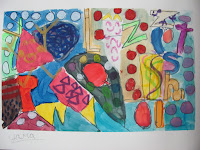At the end of the school year I am often left with a bitter-sweet feeling. I am sad to say goodbye to students, some of whom I have worked with in the art room for five or six years. Yet, I am gratified to look back at the year and reflect on how much art making we have shared, and how much we have learned from each other. I am also inspired to realize how much growth has happened in just one year. Creative endeavors provide such a good venue for learning about ourselves and one another. I hope all of you can carve out some time over the summer to tinker, ponder, create, and enjoy each other's company!
***************************************************************************
Primary Artists have been diving deep into the life of birds in their classroom studies. In art class they created ceramic bird's nests. The giggles while they were squeezing clay through the garlic presses were priceless! In addition to the bird's nests, they have enjoyed experimenting with some sewing. They sewed on "foam paper" with embroidery thread. Some students chose to punch holes for their stitches; others used the needle to poke the hole. One artist discovered that if he pulled the thread tightly he could cause the foam to curl!
*******************************************************
Kindergarten Artists completed their classroom study of farms by making Wacky Farm Animal Collages in the art room. The amount of imagination involved in the project was impressive. Some students chose to work together in order to share their observations of how a particular farm animal looked, while others worked individually. In addition to the collages, the young artists celebrated Earth Day with collaborative paintings honoring our earth:
*********************************************************
First Graders recently completed their study of Mexico. They enjoyed loom weaving using brightly colored yarn reminiscent of textile art in Mexico. The students observed that some of them seemed to make longer weavings than others during class, even when everyone was focused and working at about the same rate. Then one student pointed out how much thicker and dense some weavings were (the shorter ones) and how the longer ones were more loosely woven. This is a perfect example of how observation, one of *Harvard's Project Zero Studio Habits of Mind, can be practiced in the art room for critical thinking (see more about this at the bottom of this blog).
In collaboration with our music teacher, Ms. Rhodes, the students painted their "Recycled Musical Instruments" in art class. There is a great variety among the instruments in terms of size and shape!
***********************************************************
Second Grade completed their Southwest Landscape Series. It is fascinating to see how they interpreted the landscape through three different art mediums: drawing,
watercolor painting, and collage. These beautiful pieces will be on display in the main hallway for Graduation. In addition to this project, the students made ceramic coil pots. The pots are challenging as they involve several steps in order for the coils to stay attached. Both of these projects represent the last of their classroom Native American Studies this year.
****************************************************
Third Graders worked on their design paintings for several weeks. The project was the result of a brief introduction to abstract art. In preparation for the project, the students discussed abstract and representational art. Then students looked at images of art and sorted them into piles of abstract images and representational images. This was more difficult than they originally thought it would be. Some of the art was depicting real things, like people, but it was expressed in an abstract way. I wonder if artists would agree with how art historians classify their work? The discussion was quite interesting. After this exercise they started their own paintings. In addition to the paintings, the students worked on ceramic animal pots. The pots were challenging and allowed them to use many of the skills they have learned over the years.
***************************************************************
MOREART: Students in the after school program enjoyed Open Studio time throughout the year as they explored various art mediums and collaborated spontaneously with students from other classes. If you are interested in enrolling your student (K-3) in MOREART next year, keep an eye out for the after school enrichment enrollment emails from CHS over the summer and/or early in the fall.




*Eight Studio
Habits of Mind was developed by artists and educators associated with
Project Zero at Harvard. These “Habits of Mind” were identified as ways of
thinking that are unique to learning in a studio environment, thus
demonstrating the real benefits of a Visual Arts Education. They include Developing Craft, Engaging & Persisting, Envisioning, Expressing, Observing, Reflecting, Stretching & Exploring, and Understanding the Art World (I include collaborating in this category). I use this as a framework when developing projects and activities for art class. I also reflect with students about the art process so that they can recognize when they are using these ways of thinking.









































